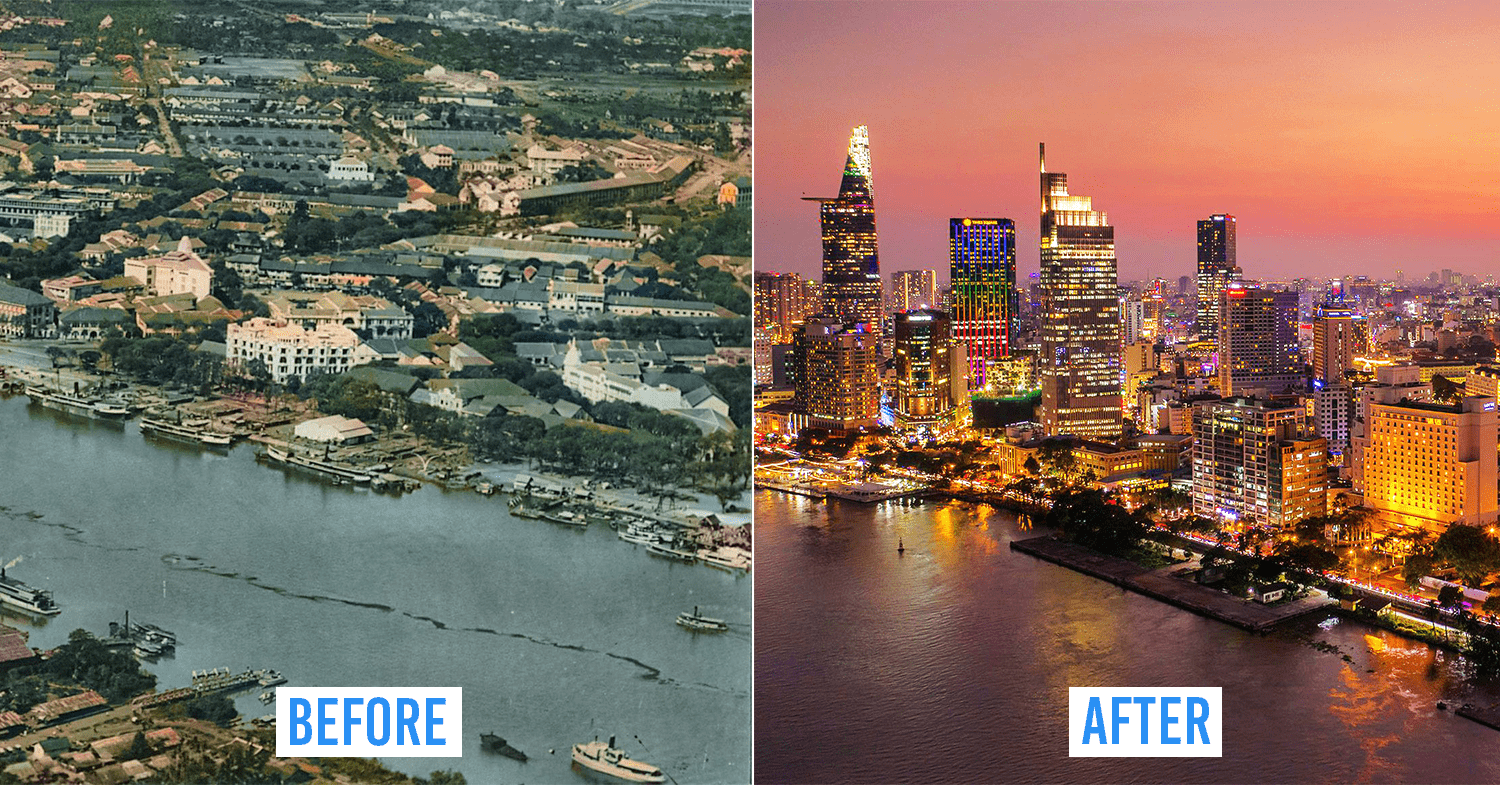Photos of Saigon landmarks then and now
First established as a major city in 1698, Saigon has been through 322 years of monumental events and significant transformations. From the bombing of Norodom Palace to the Fall of Saigon in 1975, rapid postwar economic development and population growth, many Saigon landmarks that have witnessed these happenings continue to be icons of our city.
Let’s take a look at how the city has changed over those years through these photos of Saigon landmarks and key sites.
Table of Contents
- Photos of Saigon landmarks then and now
- 1. Notre-Dame Cathedral Basilica of Saigon
- 2. Tân Định Church
- 3. The Grand Post Office
- 4. The Independence Palace
- 5. Ho Chi Minh City Museum
- 6. Saigon Opera House
- 7. Tôn Đức Thắng – Đồng Khởi intersection
- 8. Ho Chi Minh City People’s Committee Hall
- 9. The Grand Hotel
- 10. Bình Tây Market
- 11. Bến Thành Market
- 12. Bùi Viện Area
- 13. Thiên Hậu Pagoda
- 14. Chợ Rẫy Hospital
- 15. Lê Hồng Phong High School For The Gifted
- 16. Nguyễn Thị Minh Khai High School
- 17. Tân Sơn Nhất Airport
- 18. Hoàng Diệu Street in District 4
- 19. The Turtle Lake
- 20. Trần Hưng Đạo Street in District 5
- 21. Saigon River and Tôn Đức Thắng Street
- Saigon landmarks that have lasted over the past 3 centuries
1. Notre-Dame Cathedral Basilica of Saigon
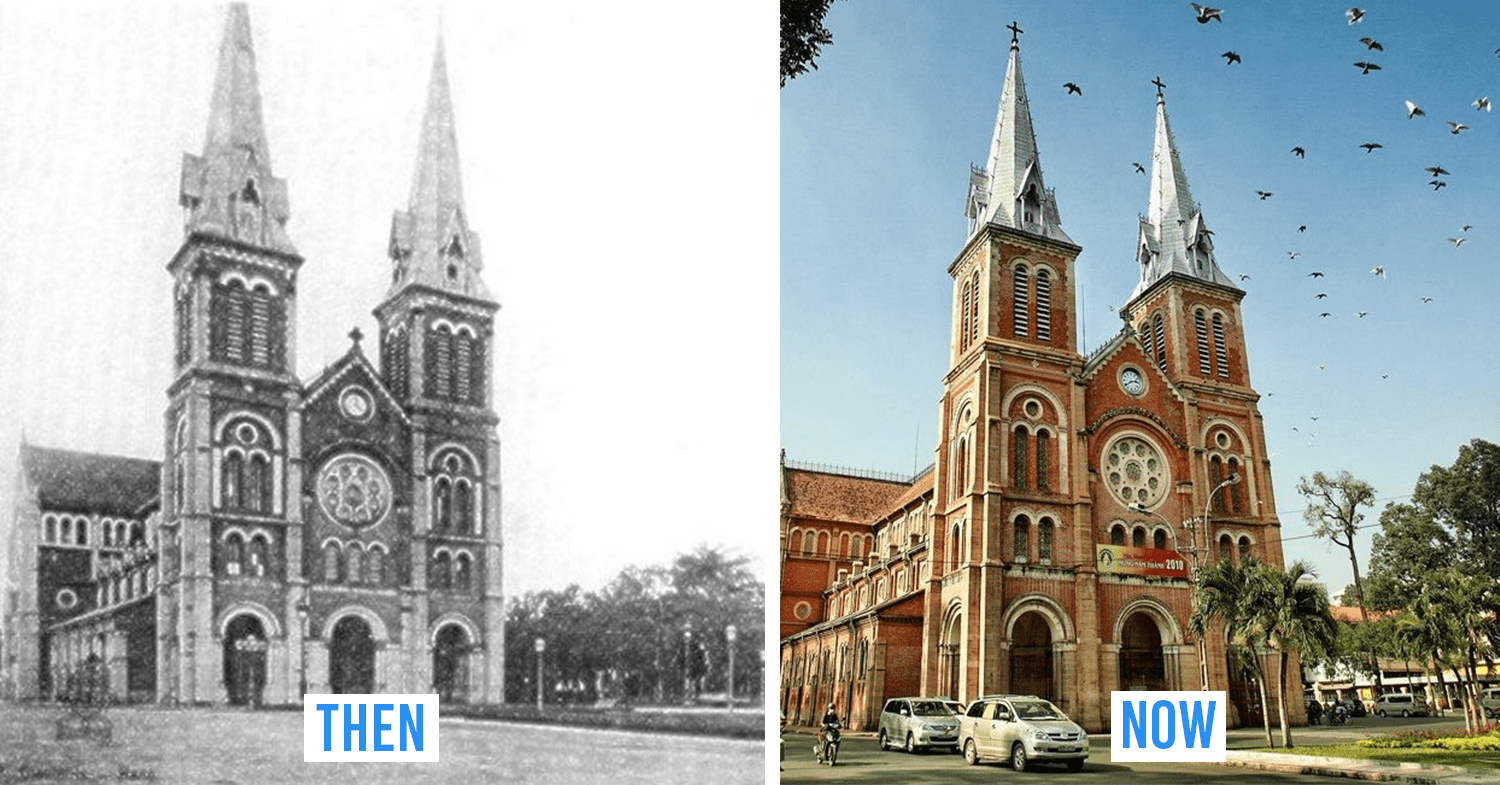
Image adapted from: anhxua.net and mytour.vn
You know you’re in Saigon when you spot the Notre-Dame Cathedral Basilica of Saigon, as this Catholic church has been the most recognized icon of the city ever since its establishment in 1865. The church has 2 bell towers and is 58M high.
Accessible via Hai Bà Trưng Street, Công Xã Paris, and Lê Duẩn Street, the church is also adjacent to the Grand Post Office and the Book Street. All of the original building materials were imported from France, including the tiles carved with words and sparkling stained glass windows.
 Image adapted from: Saigon Viewers
Image adapted from: Saigon Viewers
The church is currently fenced off for renovation and has not been open to visitors since 2015. Catholics are still welcome to attend masses on Saturday and Sunday.

Inside Saigon’s 155-year-old Notre-Dame Cathedral
Image credit: Wikimedia Commons
Address: 1 Công Xã Paris, Bến Nghé Ward, District 1, Ho Chi Minh City
2. Tân Định Church
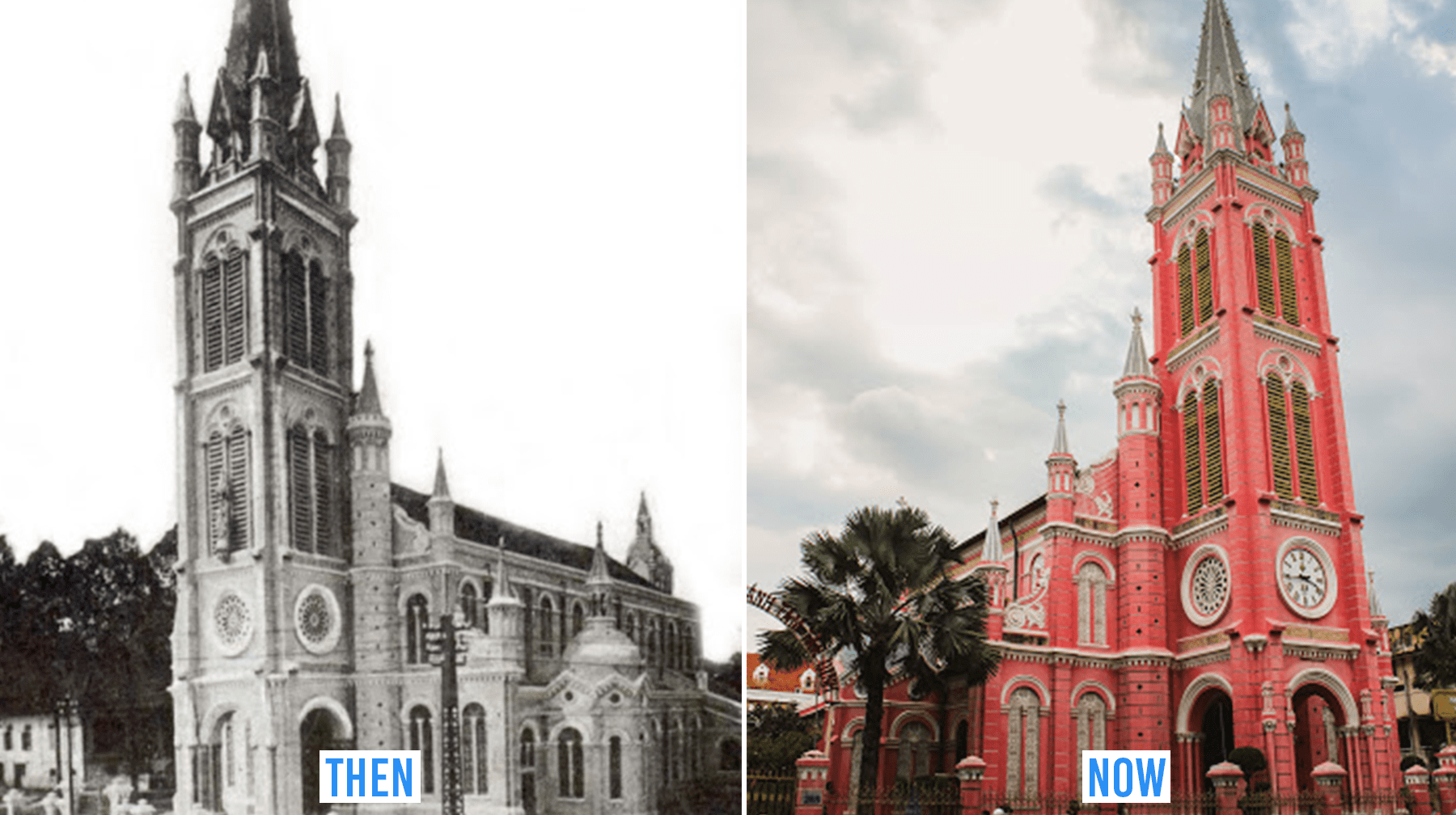
Image adapted from: Giáo Xứ Tân Định and kyluc.vn
No pink enthusiasts should skip a visit to Tân Định Church when in Saigon, as this famous church soaked in pink has also recently been named one of the world’s most beautiful pink places by Condé Nast Traveler. It’s also one of the most Instagrammable spots around the city.

Tân Định Church in the old days
Image credit: Giờ Thánh Lễ
Built in 1876 and painted pink in 1957, this is the 2nd biggest church in Saigon and fabled for its thoroughly pink color and a combination of sophisticated Romanesque, Gothic, and Renaissance architectural elements.
The church is coated in 3 different shades of pink – salmon pink on the exterior, and strawberry and pastel pink on the inside.

Inside Tân Định Church
Image credit: Giờ Thánh Lễ
Under Father Donatien Eveillard (1835-1883), the church housed an orphanage, a boarding school called Ecole de Tan-Dinh, and a Catholic publishing house where he and the nuns taught disadvantaged children publishing skills so they could make a living in future.
Father Eveillard had made considerable contributions to the church and was a highly admired figure among the local community. When he died in 1883, he was buried beneath the nave of the church.
 Image credit: Giờ Thánh Lễ
Image credit: Giờ Thánh Lễ
Address: 289 Hai Bà Trưng, Ward 8, District 3, Ho Chi Minh City
3. The Grand Post Office
 Image adapted from: ngochieppham blog and bizlive
Image adapted from: ngochieppham blog and bizlive
Built from 1886 and 1891, Saigon’s Grand Post Office (Bưu điện thành phố) is a time-honored landmark that exudes immense splendor and dynamism at the same time.
Designed by French architect Alfred Fouhoux, it features typical neo-Baroque elements through a dramatic grand foyer that draws one’s eyes upwards to the high and decorative ceiling, as well as plenty of arched windows and wooden shutters.

The Post Office in 1969
Image credit: baotreonline.com
Located adjacent to the Notre Dame Cathedral, the two historic architectural sites can be visited back to back, so you have a full picture of what it used to be like being in the city center during the Indochinese era.

Inside the Post Office today
Image credit: vietfuntravel.com
The post office is still in full operation, so you can access a full range of postal services here as well as buy souvenirs.
Address: 2 Công Xã Paris, Bến Nghé Ward, District 1, Ho Chi Minh City
4. The Independence Palace
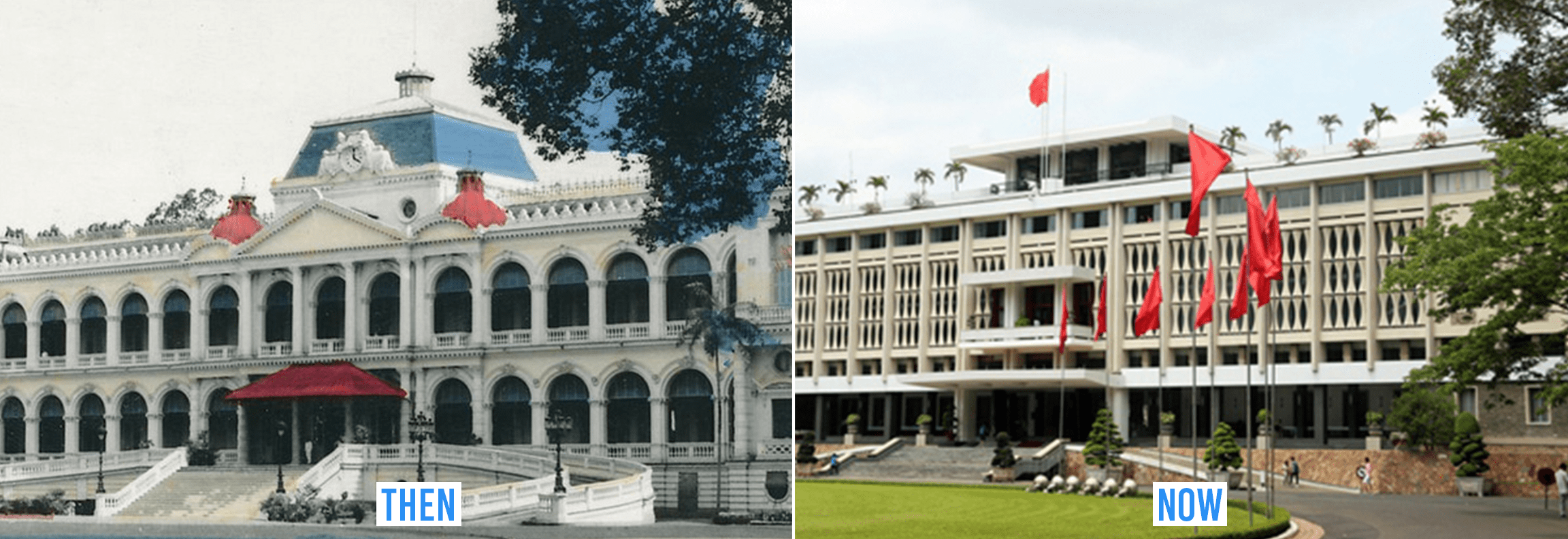 On the left is the Norodom Palace in the 1890s
On the left is the Norodom Palace in the 1890s
Image adapted from: VNTrip and Vườn Ươm Tri Thức
The Independence Palace, also known as the Reunification Palace, was formerly known as Norodom Palace, and is a key landmark in Saigon.
After the French occupation of southern Vietnam, its governor held a ceremony to build the complex in 1868, which was then completed in 1873 and named Norodom Palace. The palace was designed by architect Achille-Antoine Hermitte, who also designed the Hong Kong City Hall, and it was used as the residence and office of all of French Indochina’s governors.

Noromdom Palace before being bombed
Image adapted from: Saigon Viewers
During the Diệm administration, the palace was called the Independence Palace (Dinh Độc Lập). On 27 February 1962, the palace was bombed in an assassination attempt, leaving the entire left wing destroyed. The palace was commissioned to be demolished, and a new one built in its place. Its designer was Ngô Viết Thụ – a Vietnamese architect who won the Grand Prix de Rome in 1955.

The cabinet room of the South Vietnam administration cordoned off
Image credit: Vietnam net
Completed in 1966, the new structure has remained unchanged to this day, both outside and inside, even after it went through multiple transitions of ownership between administrations. After 1975, it was renamed the Reunification Palace (Dinh Thống Nhất), but the names “Independence Palace” and “Reunification Palace” are still used interchangeably.
Visiting the Independence Palace today, you can tour the chambers and workplaces of its former owners which have been cordoned off for preservation. You can also see the Vietnamese T-54 tank in the gardens at the entrance of the palace, a vehicle which was used by Vietnamese communists to knock down the palace gate on 30th April 1975 – the moment that ushered in the Fall of Saigon.
Address: 135 Nam Kỳ Khởi Nghĩa, Bến Thành Ward, District 1, Ho Chi Minh City
5. Ho Chi Minh City Museum
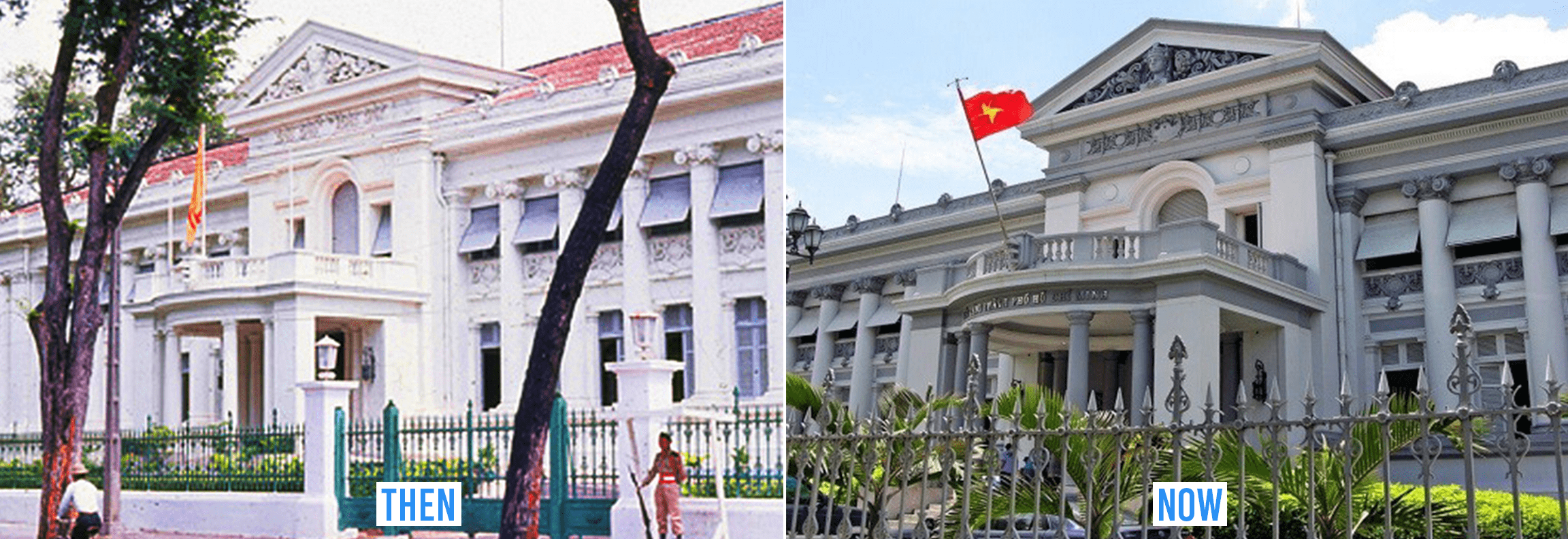
Gia Long Palace (left) in 1960s
Image adapted from: Nam Kỳ Lục Tỉnh and LKTC
Ho Chi Minh City Museum, formerly known as Gia Long Palace (Dinh Gia Long), is a historical site situated at the intersection of Lý Tự Trọng and Nam Kỳ Khởi Nghĩa streets. It’s about a 10-minute walk from the Independence Palace.
Designed by French architect Alfred Foulhoux, Gia Long Palace was constructed in 1885 and completed in 1890. The ownership of the building was changed multiple times during the World War II era, transitioning from the French colonists to the Japanese occupants.

Gia Long Palace in 1953
Image credit: manhhai
From 1954 to 1963, Gia Long Palace became the residence of South Vietnam’s President Ngô Đình Diệm and his brother Ngô Đình Nhu’s family. From then on until 1975, it housed the Supreme Court of the Republic of Vietnam.
Today, the building is known as the Ho Chi Minh City Museum, exhibiting a range of artworks and artifacts.
Spanning 1,700 sq m, the 2-storey building features classical Baroque architecture. Its interior designs are European-styled, while its roof features grotesque carvings at the front face and several embossed motifs depicting Greek mythological symbols. The interiors of the building remain unchanged, while the paints on the exterior have gone from white to light grey.
Address: 65 Lý Tự Trọng, Bến Nghé Ward, District 1, Ho Chi Minh City
6. Saigon Opera House
 Image adapted from: Hinh anh Viet Nam and Dan
Image adapted from: Hinh anh Viet Nam and Dan
Saigon Opera House, or the Municipal Theatre of Ho Chi Minh City, was built in 1897 by French architect Eugene Ferret. It was initially built to serve as the Lower House Assembly for the South Vietnam administration after 1965. After the reunification of Vietnam in 1975, the building was used as a theatre and went through a revamp in 1995.
Located on the city’s central axis, the theatre is connected to the existing metro station and the surrounding streets leading to Bến Thành Market.
 Saigon’s Opera House during the French colonial rule
Saigon’s Opera House during the French colonial rule
Image credit: kienthuc.net
It can host 1,800 people at any time, and is constructed with 2 layers of doors to stall traffic noise. Resembling the Petit Palais in France, it incorporates the flamboyant style of the French Third Republic. Its central archway at the main entrance, flanked by two wings, is roofed by a dome and accessed via a broad set of steps.

Image credit: gody.vn
The theatre is now used to host high-profile events and entertainment activities in the city. As you can see, not much of the facade has changed over the centuries.
Address: 7 Công Trường Lam Sơn, Bến Nghé Ward, District 1, Ho Chi Minh City
7. Tôn Đức Thắng – Đồng Khởi intersection
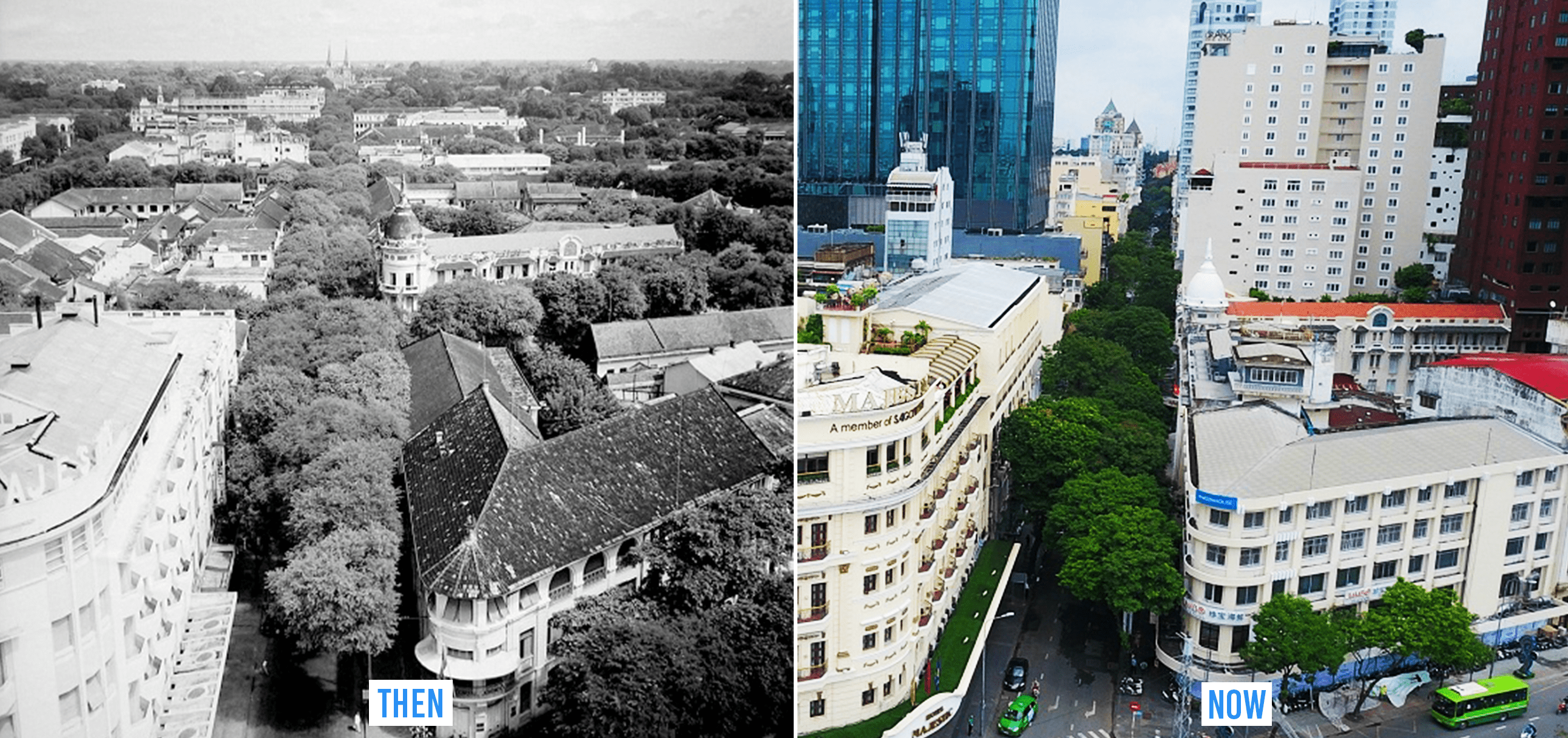 Image adapted from: nhacxua.vn
Image adapted from: nhacxua.vn
The intersection of Đồng Khởi and Tôn Đức Thắng streets, where the road leads straight to the Notre Dame Cathedral, is a historic one. Formerly known as Rue Catinat, Đồng Khởi Street is home to the most prestigious and expensive venues in Saigon, such as the Hotel Majestic on the left.

Another view of the intersection seen from street level in the past
Image credit: VnTrip
The 105-year-old Hotel Majestic is an unmissable landmark on District 1’s skyline, and once received many movers and shakers of the world, including King Leopold of Belgium, French President Francois Mitterand, and actress Catherine Deneuve.
 Hotel Majestic today
Hotel Majestic today
Image credit: Saigon Viewers
The building across from the Hotel Majestic used to be the Grand Hotel de la Rotonde in the 1900s, and is now used to house restaurant Runam Bistro.
 Image credit: Sài Gòn Xưa
Image credit: Sài Gòn Xưa
Nothing much has changed when viewing the street from the same angle, except that the roof of the former Grand Hotel de la Rotonde has been flattened and the building given a new coat of paint. There are also more high-rise buildings lining the streets nearby, such as the Saigon Times Square.

The former Grand Hotel de la Rotonde building, now housing the Runam Bistro
Image adapted from Google Maps
8. Ho Chi Minh City People’s Committee Hall
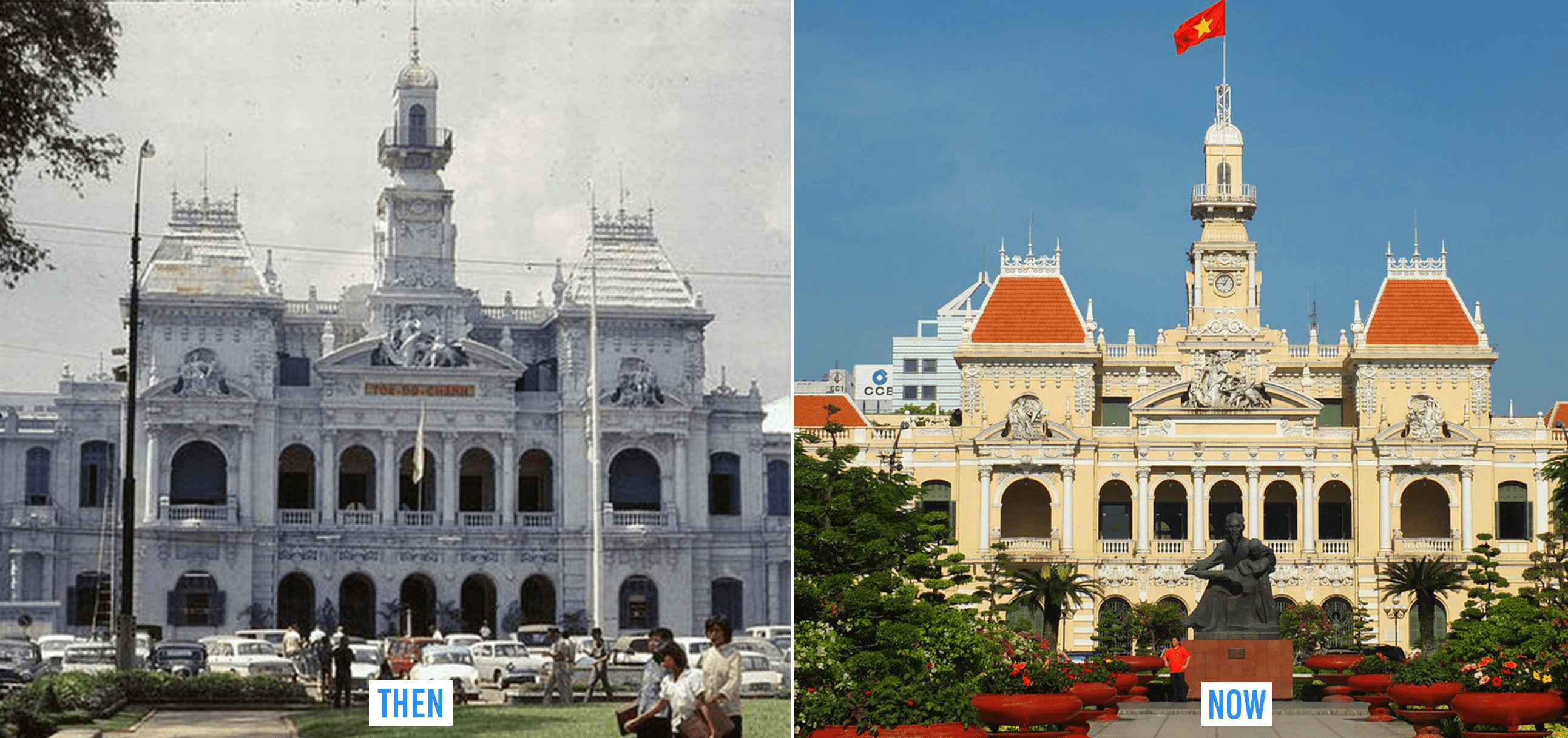 Image adapted from: Sài Gòn Mến Yêu and Dan
Image adapted from: Sài Gòn Mến Yêu and Dan
Saigon residents in the 1900s would have been familiar with the Hôtel de Ville, now the Ho Chi Minh City People’s Committee.
Till today, this is still a spectacular architectural work with its ostentatious facade and flamboyant interiors remaining unchanged. The only transformation is in its coat of paint, transitioning from thorough white to yellow on the walls and red on the roofs – also the most widely used colors in colonial properties across the city.

Bird’s eye view over the People’s Committee and Nguyễn Huệ Pedestrian Street
Image adapted from: Saigon Viewers
Boasting a 66M wide facade incorporating Baroque, Rococo, and Art Nouveau architectural styles, it is ornamented with a bare-breasted sculpture portraying Marianne, the French Revolution’s symbol, and fluted pilasters with intricately decorated capitals.
 Image credit: VnExpress
Image credit: VnExpress
Its interiors are packed with grandiose decor, including a luxurious central staircase leading up to a grand hall graced with extravagant ceiling murals and rare paintings.

Image credit: VnExpress
The building was constructed in 1902, completed in 1908, and inaugurated in 1909, marking the 50th anniversary of the French presence in Saigon. Unfortunately, the building is not open to the public – so we can just marvel at its exterior for now.
Address: 86 Lê Thánh Tôn, Bến Nghé Ward, District 1, Ho Chi Minh City
9. The Grand Hotel
 Image adapted from: nhacxua.vn
Image adapted from: nhacxua.vn
Situated on No. 8 Đồng Khởi Street in District 1, formerly the Rue Catinat, the Grand-Hôtel Saigon was built in 1929 during the Indochinese era, boasting 68 rooms. 2 years later, it was sold to Frenchman Patrice Luciani, and renamed Saigon Palace.
 Inside the Grand Hotel
Inside the Grand Hotel
Image credit: Booking.com
Hosting regular entertainment events for the upper class, Saigon Palace soon became one of Saigon’s most successful hotels and was frequented by Indochina’s most high-profile people in the 1930s.
Built in the Neoclassical style with both wings widened on two frontages, the building exudes a princely vibe with a striking dome roof easily spotted from anywhere nearby, plenty of shuttered windows with corbels, and arched doors. It was rumored that Graham Greene, the author of The Quiet American, drew inspiration from one of the rooms in this hotel when depicting Thomas Fowler’s rented apartment on Catinat Street.
 A room inside the Grand Hotel
A room inside the Grand Hotel
Image credit: Booking.com
After 1975, the hotel was again renamed the Grand Hotel and more rooms and facilities were added. By 2011, the Grand Hotel became a 5-star hotel with 233 rooms offering contemporary and modern accommodation. It remains one of Saigon’s oldest and most luxurious hotels.
Address: 8 Đồng Khởi, Bến Nghé Ward, District 1, Ho Chi Minh City
10. Bình Tây Market
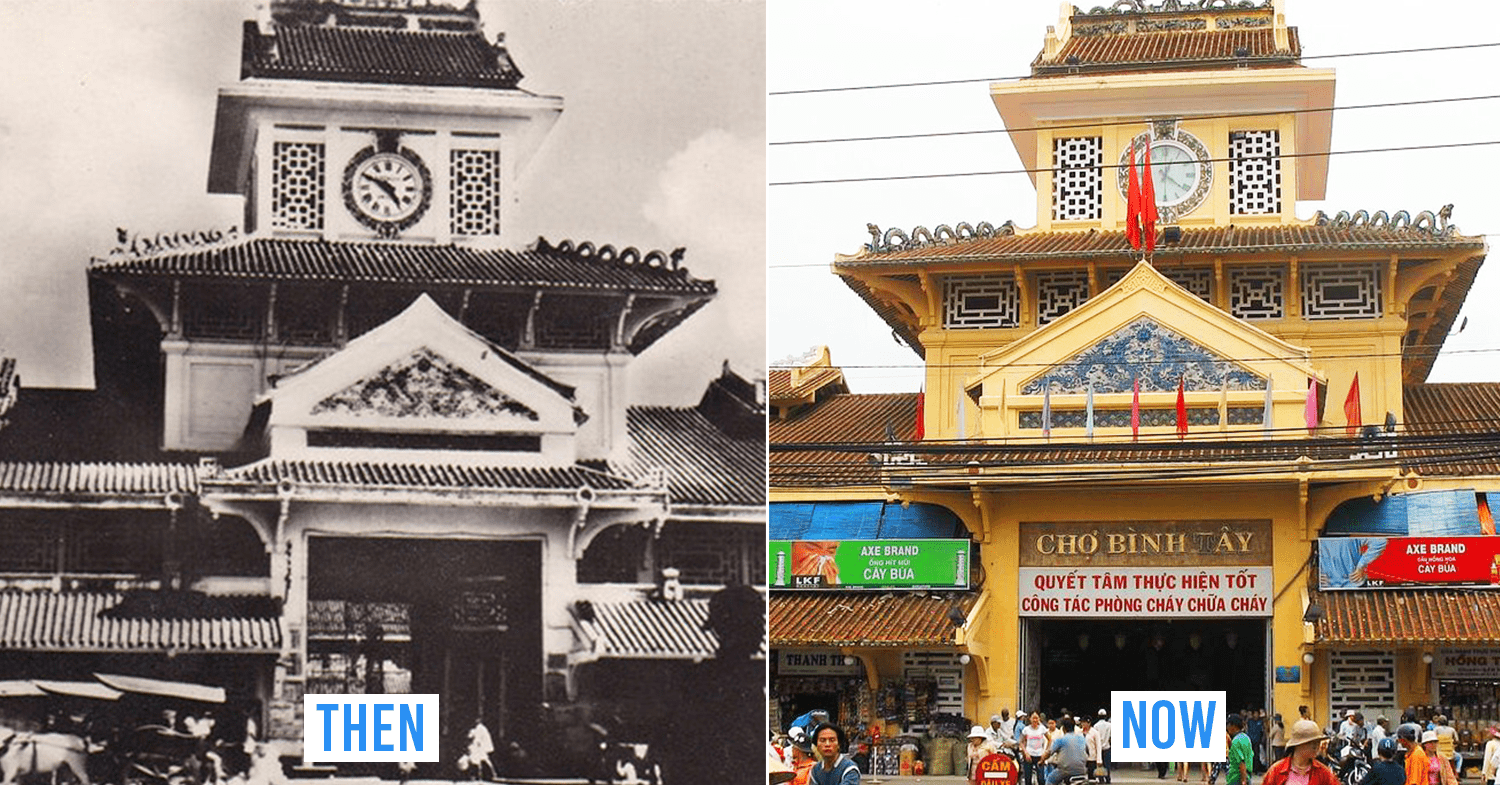 Image adapted from: hoaxuongrong.org and Wikipedia
Image adapted from: hoaxuongrong.org and Wikipedia
Constructed in the 1880s, Bình Tây Market, also known as Chợ Lớn (the Big Market), is the largest wholesale market in Saigon and situated in District 6. Over the years, the fusion of Chinese and French elements is still visible in its unique architecture.

Bình Tây Market from a bird’s eye view
Image credit: @ngocngachsaigon
It might take you more than 1 hour to actually tour the stalls selling all manner of products inside this gigantic work of architecture. Among over 2,300 stalls here, you’ll find a plethora of textile, clothing, homeware, packaged coffee and tea, as well as dry food and medicines.

Image credit: @electrique_d.kimm
The market also has a food court serving hot meals and desserts to help exhausted shoppers recharge before resuming their shopping sprees.

Image credit: @signsofsaigon
Address: 57A Tháp Mười, Ward 2, District 6, Ho Chi Minh City
11. Bến Thành Market
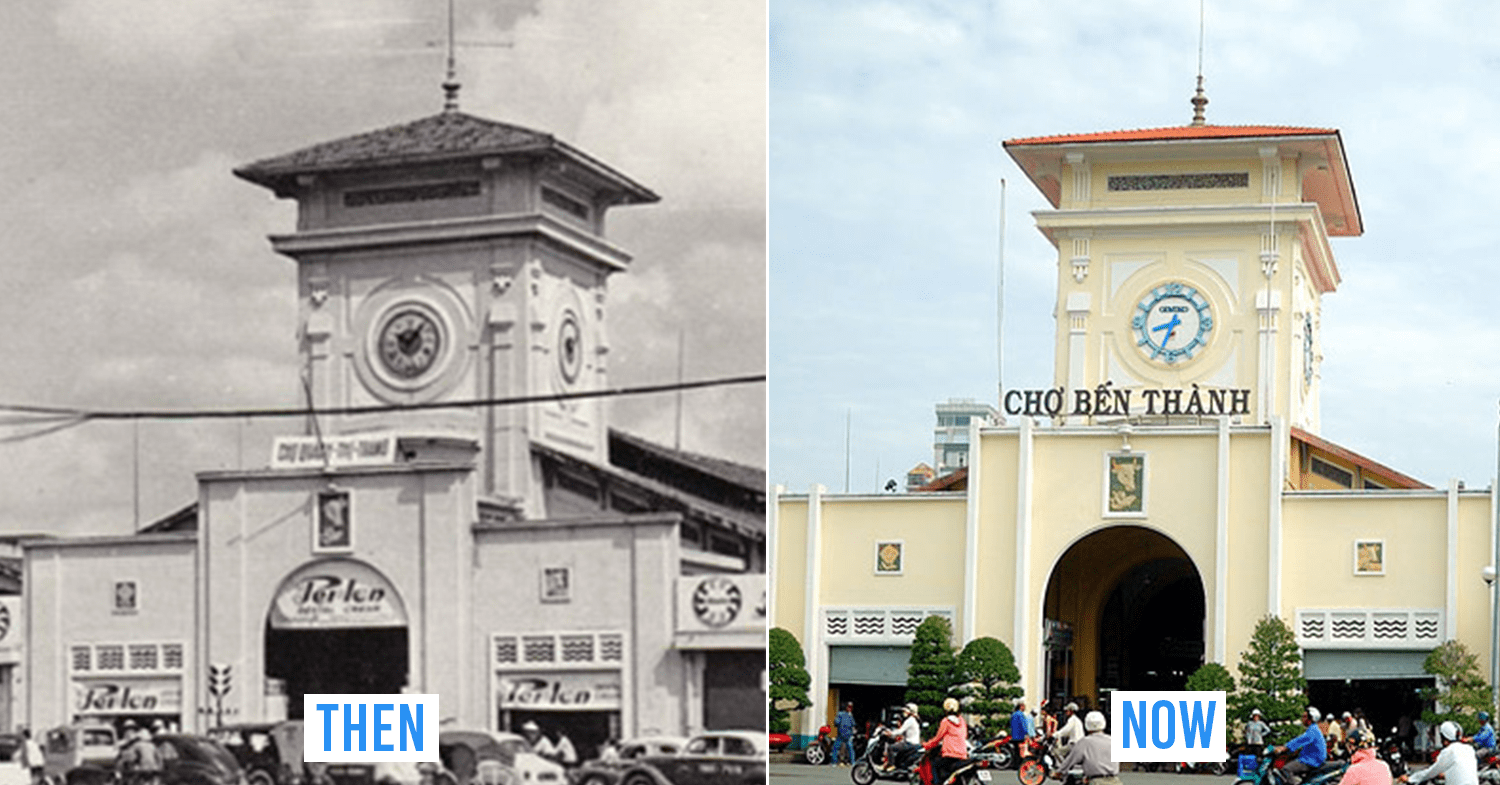 Image adapted from: cozrum
Image adapted from: cozrum
Bến Thành Market is perhaps the most famous market in Saigon due to its prime location with 4 entrances facing the biggest streets in District 1. You can access the market from Lê Lợi Street, Lê Thánh Tôn Street, Phan Bội Châu Street, and Phan Châu Trinh Street.
Home to over 1,500 stalls, this is where you can buy a wide range of commodities from handicrafts to branded goods to dry food at this market. You can also dine in its hawker-style food court, which serves plenty of options for hot meals and desserts.

Inside Bến Thành Market in 1996
Image credit: Amazing Vietnam
The market closes at around 4.30PM, but its perimeters are open to night market activities until midnight. You can check out this outdoor night market for a lot of local food, such as snails and wok-fried noodles, or buy clothes if you’re comfortable with bargaining (see #20 of our Vietnamese phrases list for tips).
12. Bùi Viện Area
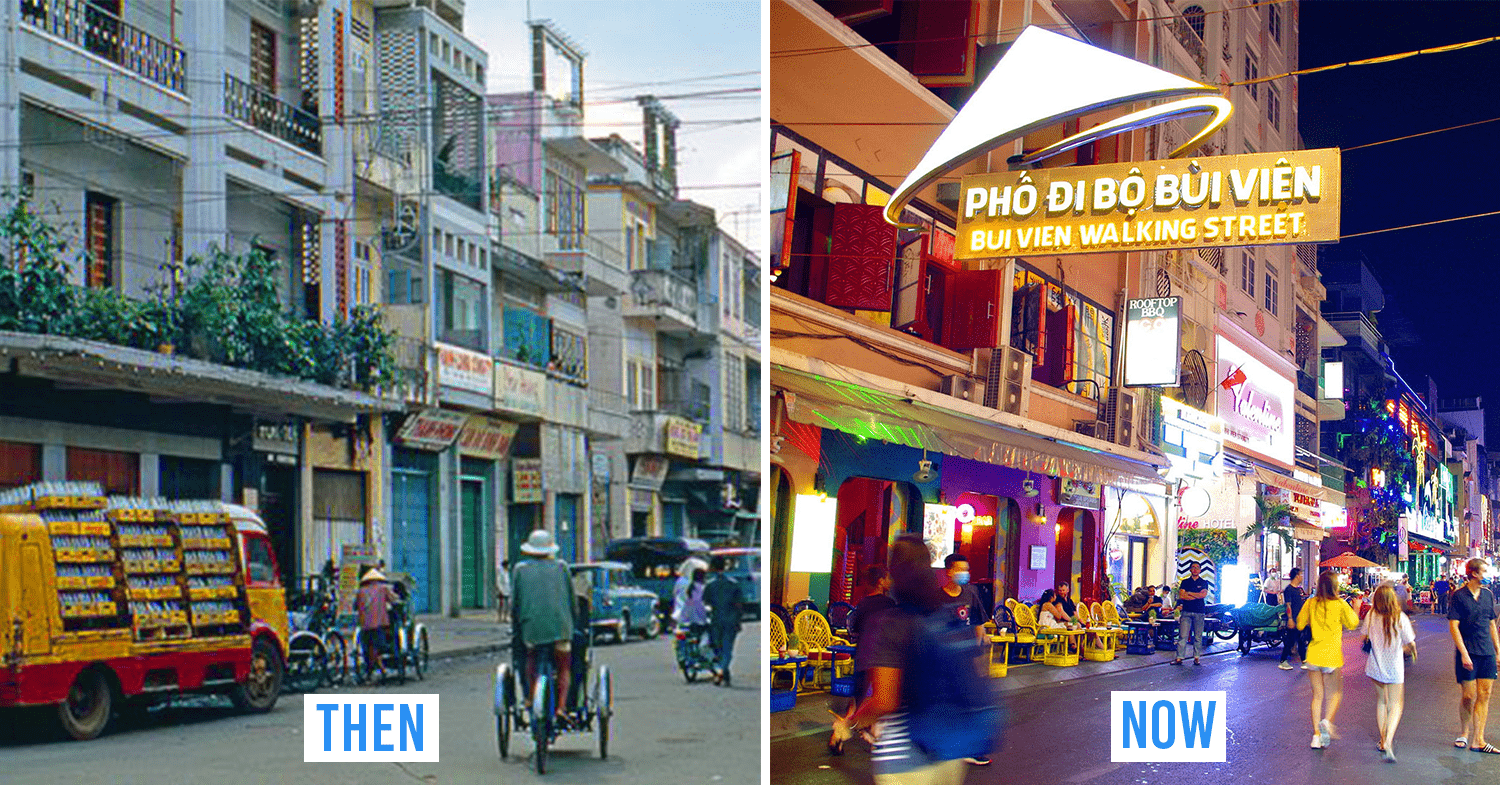 Image adapted from: nhacxua.vn and VnExpress
Image adapted from: nhacxua.vn and VnExpress
Known as the backpacker area in Saigon and home to the city’s largest numbers of nightclubs, Bùi Viện radiates raw energy with seemingly endless music and street performances.
The international flair of Bùi Viện actually dates back to the Vietnam War era in the 60s and 70s, as it was a favorite playground for GI officers with a myriad of pubs, night clubs, and Western restaurants.

Bùi Viện Street
Image adapted from: anhxua.net
Till today, this is a must-visit night street for tourists, who can rave the night away in themed bars that open from dusk till dawn, munch on a wide selection of street food, or shoot the breeze with your friends over a bottle of beer.
 Bùi Viện Pedestrian Street in the evening
Bùi Viện Pedestrian Street in the evening
Image credit: @geodomou
Address: Bùi Viện, Phạm Ngũ Lão Ward, District 1, Ho Chi Minh City
13. Thiên Hậu Pagoda
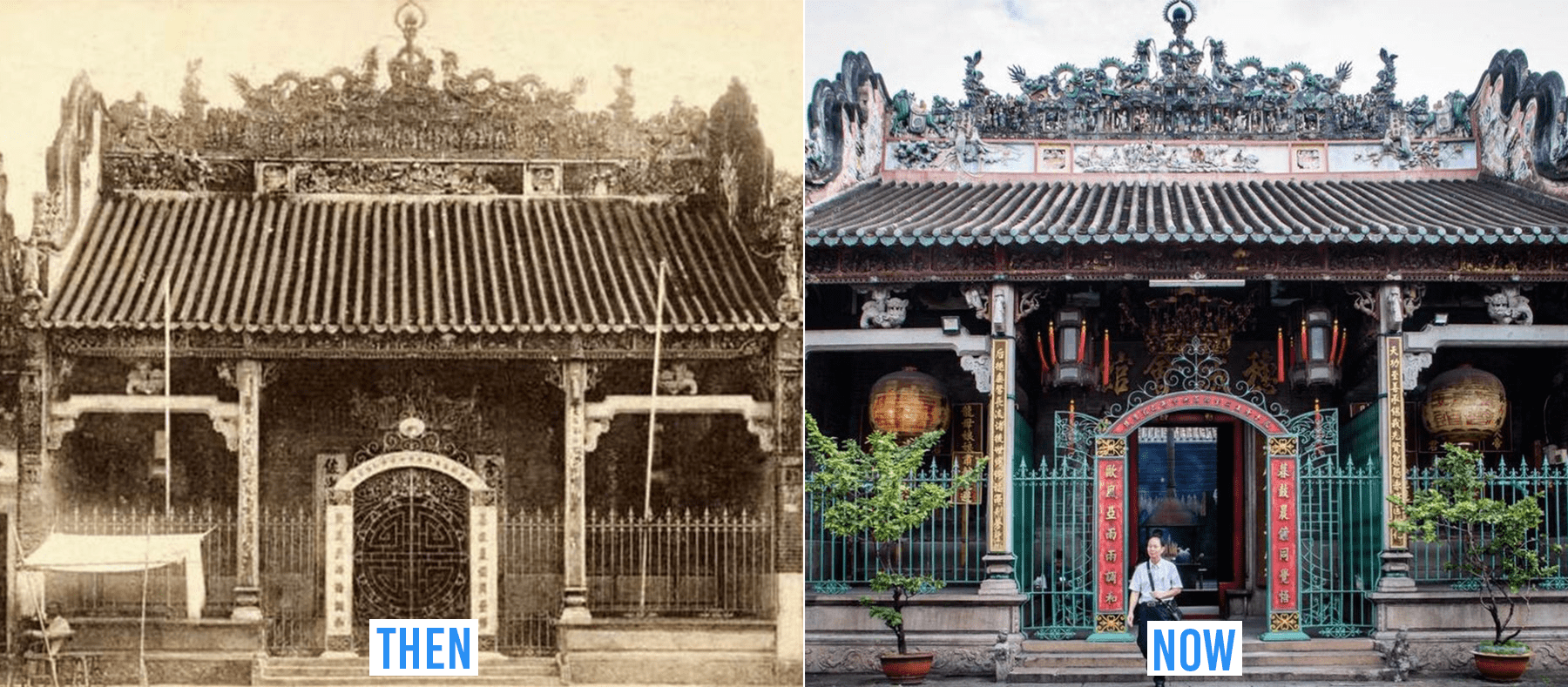 Image adapted from: Tomy Japan 79 and VnExpress
Image adapted from: Tomy Japan 79 and VnExpress
Thiên Hậu Pagoda, formerly known as Tuệ Thành Communal House, is a Chinese-style temple built in 1760 to honor Mazu, a Chinese sea goddess.
 Image credit: @mangosalata
Image credit: @mangosalata
The pagoda has 3 halls accessible via one courtyard, including a front hall featuring an offering burner, a middle hall that houses ceremonial items and a fire extinguisher dating from 1898, and the main hall, where there are shrines honoring the Sea Goddess, the Empress Golden Flower Goddess, and the Dragon Mother.

Inside the pagoda
Image credit: battrangvn.vn
Throughout centuries, the architecture of the pagoda and much of its interior elements are still well-maintained. Not only is the pagoda the go-to place for the residents of Cho Lon on special occasions or Chinese festivals to offer prayers, but it is also very popular among photographers looking for Insta-worthy snapshots.

Image credit: @hannah.v27
Address: 710 Nguyễn Trãi, Ward 11, District 5
14. Chợ Rẫy Hospital
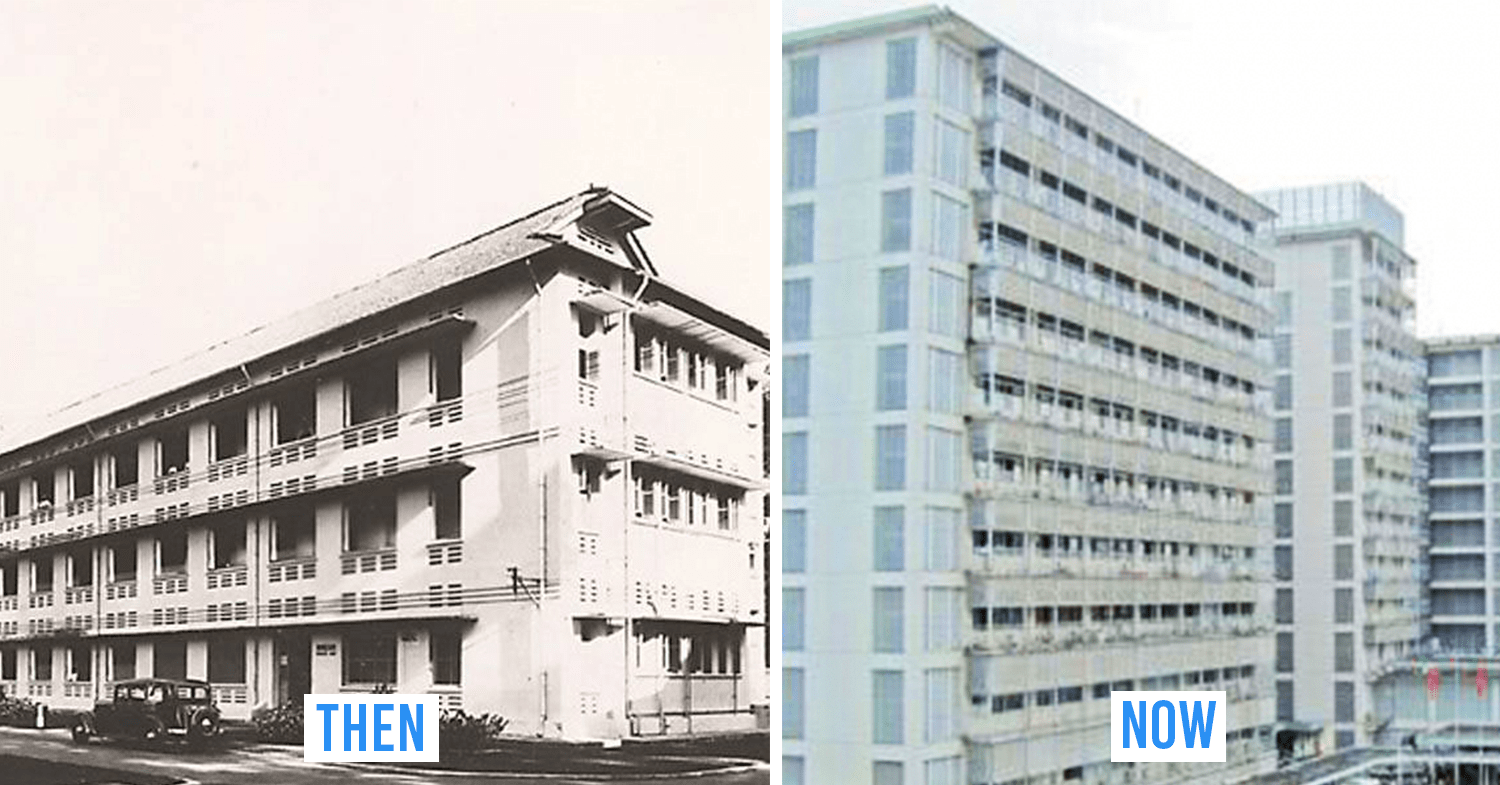 Image adapted from: namrom64.blogspot and henkham.vn
Image adapted from: namrom64.blogspot and henkham.vn
Chợ Rẫy Hospital was founded in the 1900s during French colonial rule and is one of the oldest and largest general hospitals in Vietnam.
Over the years, it’s expanded and transformed completely from a 3-storey building into a multi-storey complex to serve more patients, which amount up to 500,000 people per year.
Due to the thorough renovation, hardly any traces of French architectural elements can be found in the hospital.

Chợ Rẫy Hospital was once known as Hôpital Indigene de Cochinchine
Image credit: dansaigon.com
Address: 201B Nguyễn Chí Thanh, Ward 12, District 5, Ho Chi Minh City
15. Lê Hồng Phong High School For The Gifted
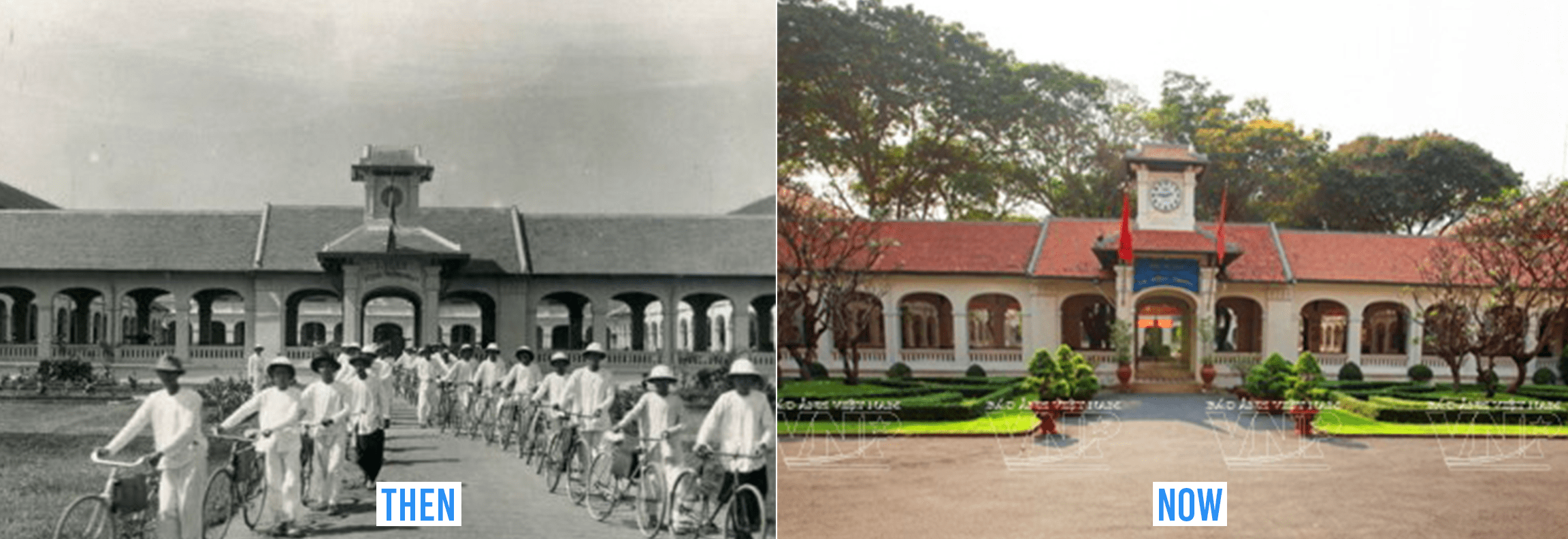 Image adapted from: tuoitre.vn and Báo Ảnh VIệt Nam
Image adapted from: tuoitre.vn and Báo Ảnh VIệt Nam
Lê Hồng Phong High School For The Gifted, formerly known as Petrus Ký High School, is one of Vietnam’s most highly ranked high schools. Established in 1927 under French colonial rule, the school is one of Vietnam’s oldest schools still in operation today.
The school was originally founded as a branch of Collège Chasseloup-Laubat (now Nguyễn Thị Minh Khai High School), named Collège de Cochinchine and used to educate local Vietnamese students. In 1928, the school was renamed Lycée Petrus Trương Vĩnh Ký after Petrus Ký, Vietnam’s most illustrious scholar of all time. By 1953, it was Vietnam’s first public all-boys’ school, teaching Vietnamese history and culture.
 The school used to be called Lycee Petrus Trương Vĩnh Ký
The school used to be called Lycee Petrus Trương Vĩnh Ký
Image credit: Sài Gòn Vi Vu
In 1976, the school was renamed Lê Hồng Phong High School For The Gifted, after a former Vietnamese communist general secretary. However, the name Petrus Ký has remained popular among its alumni and Saigon’s local residents today.
 The faculty and students of the school
The faculty and students of the school
Image credit: Sài Gòn Vi Vu
The school’s strikingly Indochinese architecture has stood well against the test of time, featuring the harmonious fusion of French architectural style and vernacular elements.
Address: 235 Nguyễn Văn Cừ, Ward 4, District 5, Ho Chi Minh City
16. Nguyễn Thị Minh Khai High School
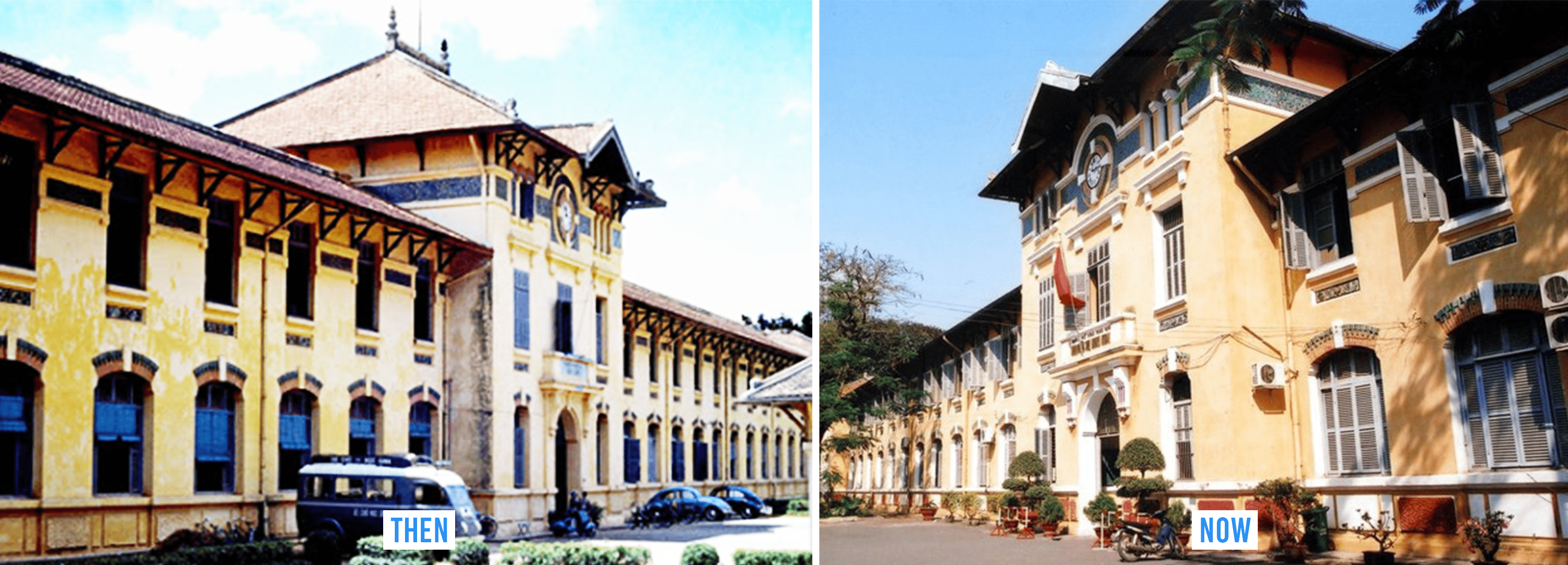 Image adapted from: ngantucuocdoi and UBND Quận 3
Image adapted from: ngantucuocdoi and UBND Quận 3
Nguyen Thi Minh Khai High School used to be a prestigious all-girls’ school during the French colonial rule. Constructed in 1913 and originally named Collège de Jeunes Filles Indigènes, or school for local female students, the school started taking in girls from different age ranges in 1922.
In 1950, the school’s name was changed to Gia Long Girls’ High School after Emperor Gia Long, and started requiring all of its students to wear purple ao dai as school uniforms. Since then on, Gia Long Girls’ High School has been given a nickname that has been popular until today – the school of girls in purple (trường nữ sinh áo tím).

A student of Gia Long Girls’ High School
Image credit: nhacxua.vn
In those days, Vietnamese students were required to communicate in French at all times, and whoever was caught chatting in the Vietnamese language would have to pay fines.
In 1940, students of both Gia Long Girls’ High School and Petrus Ký Schools joined the 1940 Cochinchina Uprising (Nam Kỳ Khởi Nghĩa), a series of patriotic demonstrations by Vietnamese southerners against the French colonial rule and Japanese occupation. This act was considered rebellious, which resulted in Gia Long Girls’ High School being shut down.
However, girls continued to protest for the school to reopen and include the Vietnamese language in the syllabus, until the school management finally gave in to their requests.
 Gia Long Girl School in 1966, photo taken by Douglas Ross
Gia Long Girl School in 1966, photo taken by Douglas Ross
Image credit: manhhai
After 1952, a Vietnamese curriculum was gradually introduced into the school system, and the first Vietnamese principal led the school. Renamed Nguyễn Thị Minh Khai after reunification, it then became a co-ed high school.
The appearance of the school hasn’t changed at all for the past centuries, except that the yellow paint on the exteriors has now taken on a slightly orange hue.
Address: 275 Điện Biên Phủ, Ward 7, District 3, Ho Chi Minh City
17. Tân Sơn Nhất Airport
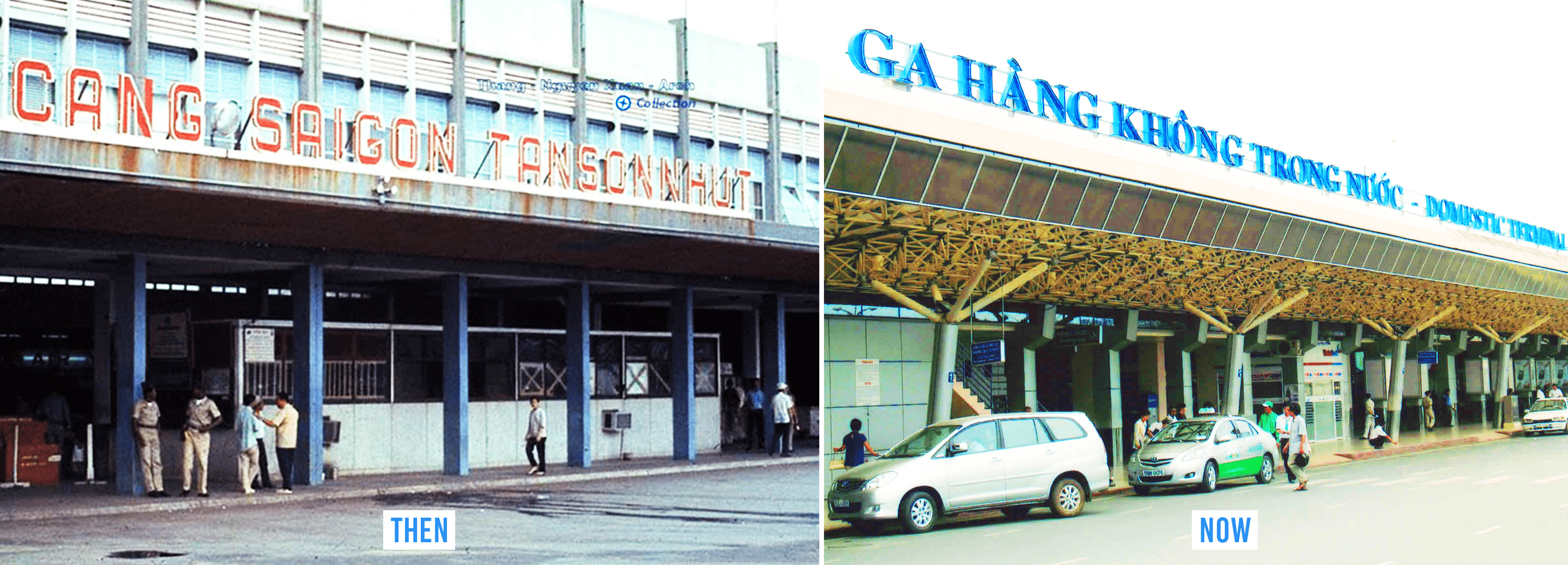
Image adapted from: Nam Ròm and vietnam-evisa
Tân Sơn Nhất International Airport (TSN) opened in 1926 in a bid to cater to the increasing demand for air travel to Indochina. In 1932, weekly commercial flights between France and Saigon were scheduled and operated by Air Orient, a France-based airline company which was merged with Air France in 1933.

Vietnamese ground service staff talking to a passenger inside Tân Sơn Nhất Airport in the 1960s
Image credit: WINDY Phan
It was not until 1951 that TSN saw the emergence of the first Vietnamese airline company – Air Vietnam, the national carrier of the Republic of Vietnam (then called South Vietnam).

Inside an Air Vietnam plane
Image credit: @Henry BK
In 1966, TSN became one of the busiest air bases in the world when the US Air Force based its headquarters there, and conducted most of its airborne operations in Indochina from the airport.
TSN was attacked many times during the Vietnam War, especially during the 1968 Tet Offensive and a few weeks before the Fall of Saigon in 1975. Enduring rounds and rounds of damage and subsequent renovations, it was impossible for TSN to retain its original appearance.

Vietnamese passengers travelling with Air Vietnam in its earlier days
Image credit: Henry BK
TSN was reopened for service in 1976. Now, it serves 130,000 transit passengers per day on average, with the total number of flights amounting up to 1,000 flights per day.
In 2019, TSN’s Vietnam Airport Ground Service Company was awarded with a 2nd prize for The Best Quality Award by All Nippon Airways, Japan’s largest airline company.
Address: Tân Sơn Nhất International Airport, Trường Sơn Ward, Ward 2, Tân Bình District, Ho Chi Minh City
18. Hoàng Diệu Street in District 4
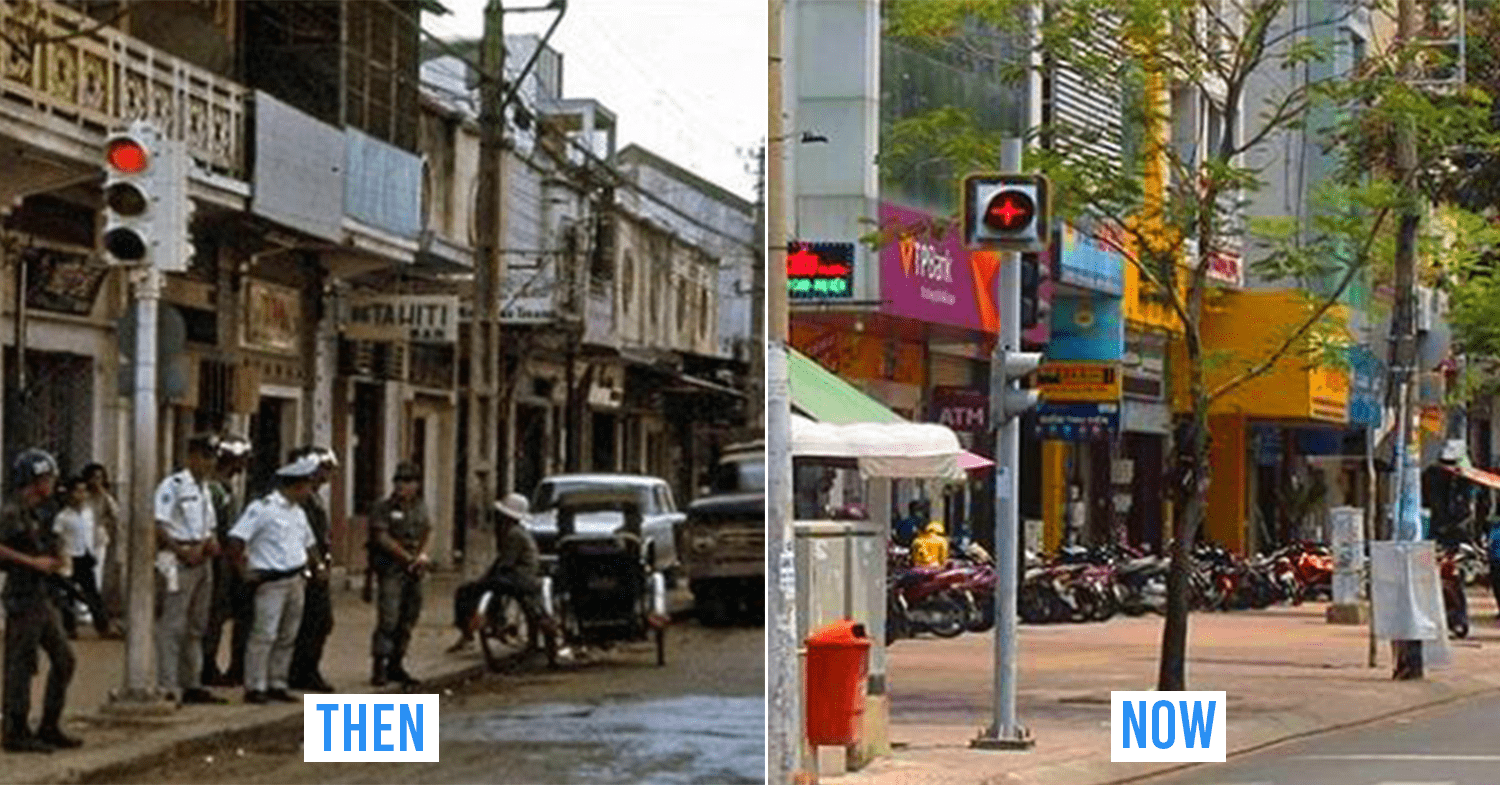 Image adapted from: @paulblizardinvietnam
Image adapted from: @paulblizardinvietnam
Hoàng Diệu Street is a major street in District 4 and only a 5 minute’s drive from the center of District 1, where you can find plenty of office buildings, coffee houses, and retail shops. The left photo depicts Hoàng Diệu Street in 1966, in which military police and national police were seen investigating an incident.
The right photo features the same spot as it is today in 2020. The traffic pole is still there, a few steps away from a TPBank transaction office and many retail shops.
19. The Turtle Lake
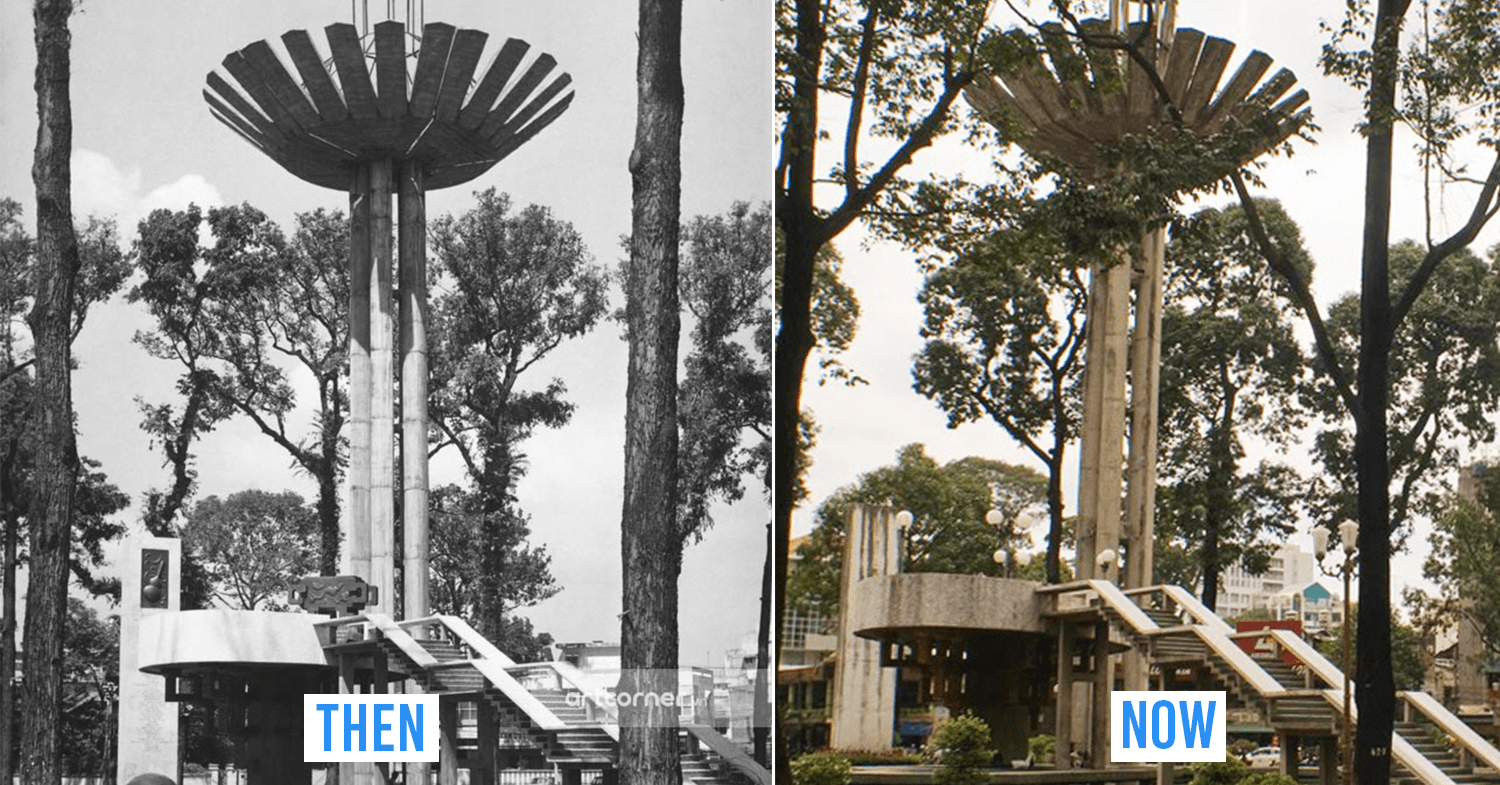 Image adapted from: artcorner.vn and saigonxua1965
Image adapted from: artcorner.vn and saigonxua1965
Breezy and spacious, the Turtle Lake (Hồ Con Rùa) is very popular among young locals needing a place to hang out and watch people under the trees. It has also been a very popular spot for dating couples since the 60s till today, because it’s located in a pretty central part of town.

A group of students and an office worker sitting at the lake
Image credit: anhxua.net
The Turtle Lake hasn’t changed at all for the past decades. It becomes more breezy and also crowded after 5, packed with young people coming back from school and sitting down by many makeshift stalls dotting the bank around the lake.
Address: Võ Văn Tần – Phạm Ngọc Thạch – Trần Cao Vân intersection, District 3, Ho Chi Minh City
20. Trần Hưng Đạo Street in District 5
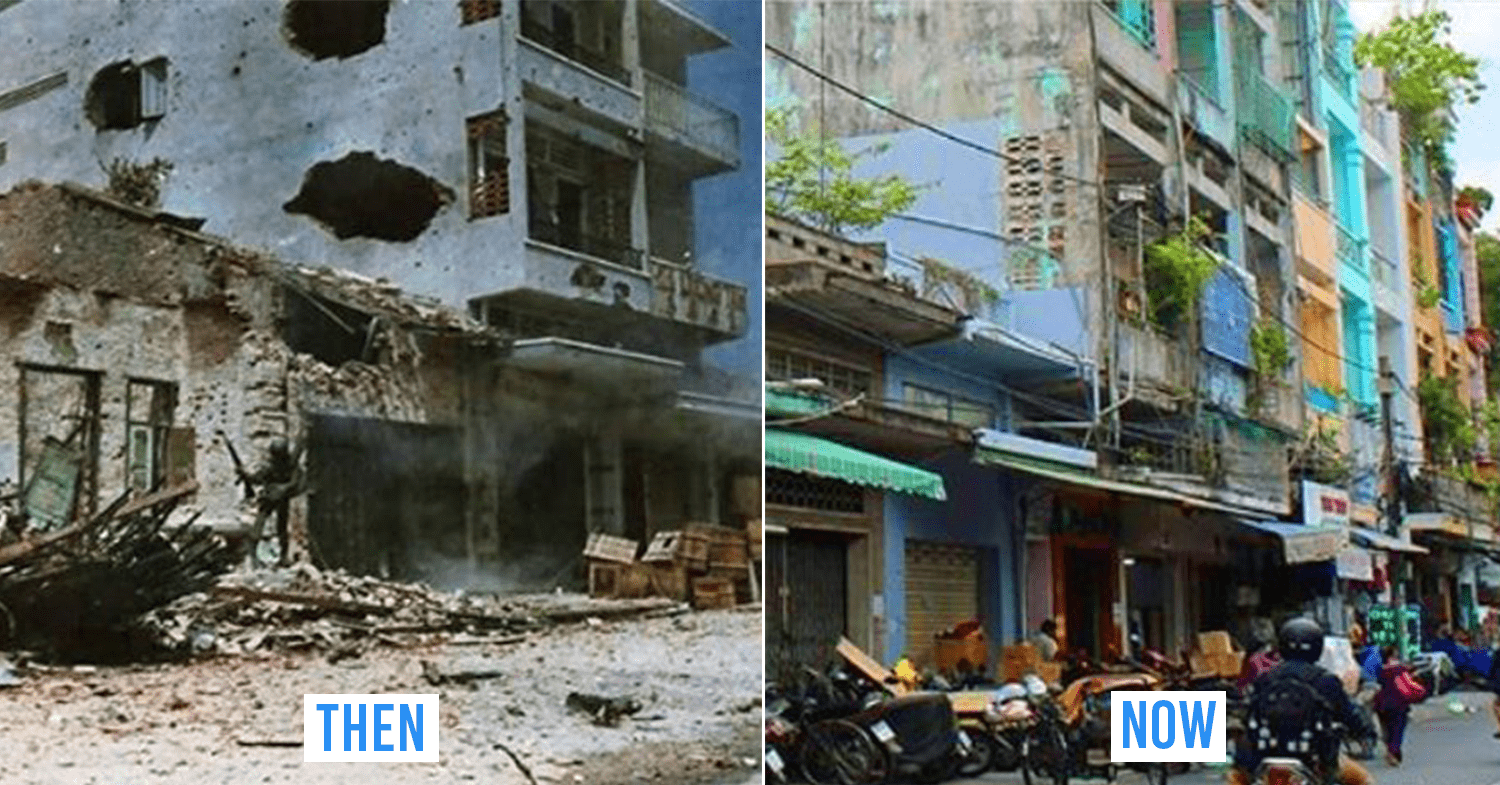 Image adapted from: @paulblizardinvietnam
Image adapted from: @paulblizardinvietnam
The left photo features a part of Trần Hưng Đạo B Street being ruined in the Tết Offensive in 1968, a surprise attack on civilians by Vietnamese communists in many cities including Saigon and Huế that killed thousands of civilians. Over 900KM away, much of Huế’s Forbidden City was damaged during this attack.
The right photo features the same spot taken in 2020 – it’s now a busy street lined with retail shops and townhouses numbered from 584 to 616 on Trần Hưng Đạo B Street in District 5.
21. Saigon River and Tôn Đức Thắng Street
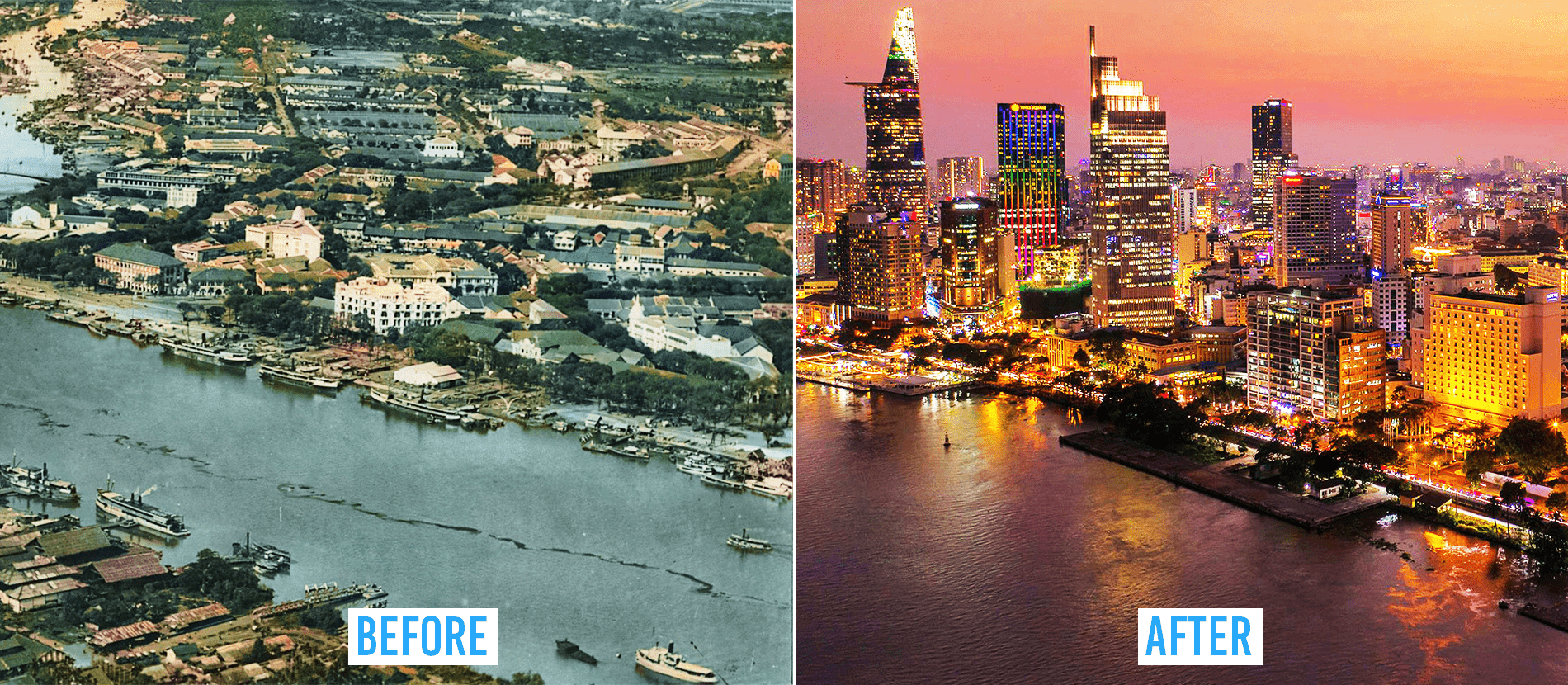 Image adapted from: Saigon Viewers
Image adapted from: Saigon Viewers
Saigon River is Saigon’s largest river and a key site that no new visitors to Saigon should miss. Tôn Đức Thắng Street, a busy route lining the river, is lined with numerous sleek skyscrapers that light up Saigon’s skyline in the evening. The street plays host to a wide array of financial establishments.
In the past, the street seemed less claustrophobic with more low-rise properties and plenty of trees. Even though it’s much busier now, one thing that hasn’t changed is that the Bạch Đằng Wharf is still here. The name Bạch Đằng was given to the wharf in 1955 in commemoration of the Bạch Đằng Battle (938 A.D), in which Vietnamese troops triumphed against Chinese invaders.
Today, Vietnamese can board a water bus from Bạch Đằng Wharf to go to District 2, District 9, and Thu Duc District.
Saigon landmarks that have lasted over the past 3 centuries
For a city that has only roughly 300 years of history, Saigon has ridden through many tides of wars and transformations. Throughout the reign of the Nguyen Lords, the French colonization, Japanese occupation, and the Vietnam War, Saigon’s landmarks have survived many adversities as the city has expanded into one of Southeast Asia’s busiest metropolises.
The charm, dynamism, and intoxicating power of this city will continue to draw new immigrants and building on its rich heritage.
Also check out:
- 9 tours near Saigon for every type of travellers
- 10 things to do in Saigon in July
- 8 beaches and islands near Saigon for a hassle-free picnic
- 23 essential Vietnamese phrases every foreigner needs to know
- Anthony Bourdain’s favorite food stall in Saigon to open in Vancouver
- Saigon to develop a smart city within the city
- Saigon’s Hong Kong-themed beer bar is a new must-check-in spot
- Hue Festival to take place from 28th August to 2nd September
- Saigon’s weekly village flea market
- Lantern Festival in Saigon’s Cho Lon to resume on 5th July
Cover image adapted from: Saigon Viewers
Enjoying The Smart Local Vietnam? Follow us on Facebook and LinkedIn for more stories like this.
